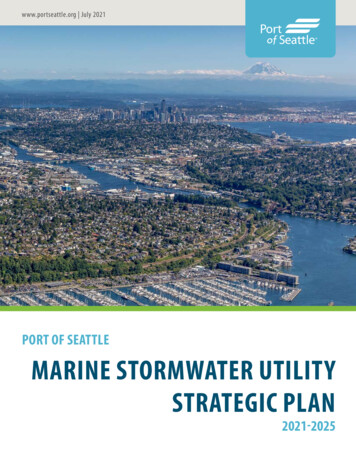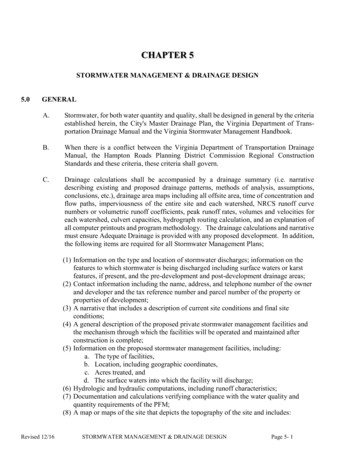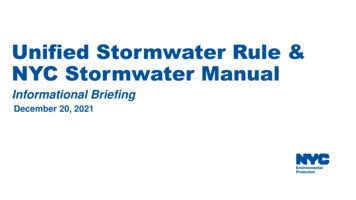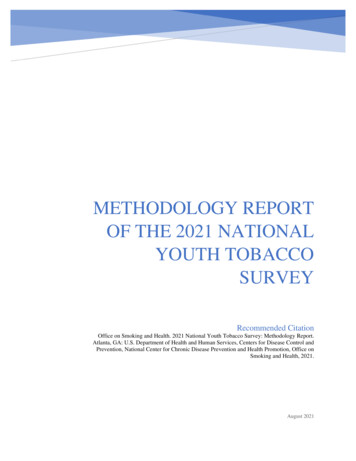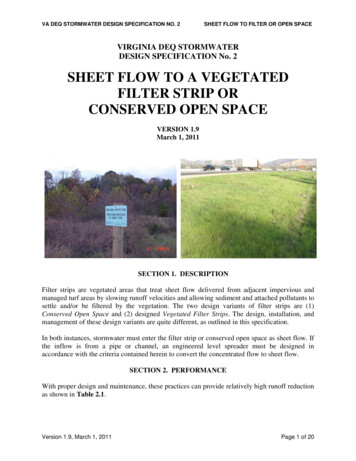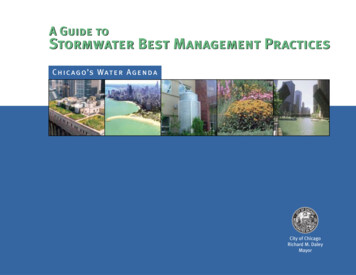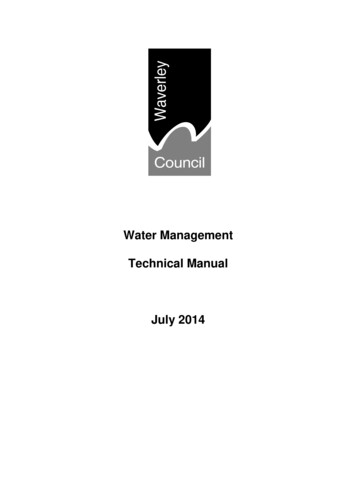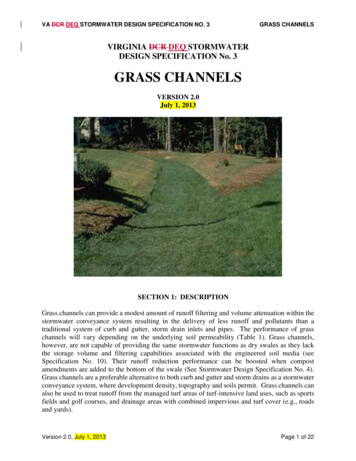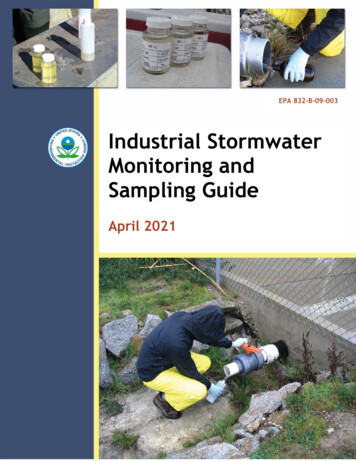
Transcription
EPA 832-B-09-003Industrial StormwaterMonitoring andSampling GuideApril 2021
This page intentionally left blank.
Industrial Stormwater Monitoring and Sampling GuideApril 2021ContentsIntroduction . 11.AIntroduction to Stormwater Monitoring and Sampling . 1Preparation for Monitoring. 42.ADetermine Where Stormwater Is Discharged From Your Property . 42.BDetermine Where You Will Collect Samples . 62.C Determine Which Types of Monitoring Requirements Apply at EachDischarge Point. 122.D Determine if Your Facility is Subject to Impaired Waters MonitoringRequirements . 192.EWhat Type of Storm Events Qualify for Monitoring . 222.FSelect the Monitoring Team . 232.GSelect a Laboratory to Analyze the Samples . 242.H Document Inspection, Assessment, and Monitoring Procedures in YourSWPPP . 25Conduct Monitoring. 263.AWhat to Have in Place Prior to Collecting Stormwater Samples . 263.BCollect Stormwater Samples . 293.CRecord Information for Each Monitoring Event . 313.DQuality Assurance Considerations . 313.EConducting Visual Assessments of Stormwater Discharges . 35Evaluate Monitoring Results . 364.AEvaluating Visual Assessment Results . 364.BEvaluating Benchmark Monitoring Results . 374.CEffluent Limitation Guideline Monitoring Results . 394.DSpecific Pollutants and Control Measure Options . 40Reporting and Recordkeeping . 435.AReporting Monitoring Data . 43Train Personnel . 47References . 48Contentsii
Industrial Stormwater Monitoring and Sampling GuideApril 2021Appendices2021 MSGP Industrial Stormwater Monitoring Form2021 MSGP Visual Monitoring Form2021 MSGP Industrial Stormwater Collection FormContentsiii
Industrial Stormwater Monitoring and Sampling GuideApril 2021List of TablesTable 1. Applicable Effluent Limitations Guidelines . 3Table 2. Solutions to Typical Stormwater Sampling Problems . 11Table 3. Example Benchmark Monitoring Requirements for Subsector G2 . 15Table 4. Required Monitoring for Effluent Limitations Guidelines . 17Table 5. Sample Preservation and Hold Times . 32Table 6. Evaluation of Benchmark Monitoring Results . 37List of Tablesiv
Industrial Stormwater Monitoring and Sampling GuideApril 2021List of FiguresFigure 1. Stormwater discharges to the slot drain and is conveyed offsite through a valvedpipe. 5Figure 2. Sewer drain. 7Figure 3. Open ditch/gutter. 7Figure 4. Facility street access point. . 7Figure 5. Outlet discharging from detention pond. . 7Figure 6. Deepening an existing ditch can allow samples to be collected directly into bottlesin some cases. Be careful not to stir up solids from the sides or bottom of the ditch. . 10Figure 7. Overland flow from vegetated areas can be sampled by constructing a shallow ditchto intercept the runoff and a deepened area to place bottles to catch the runoff. . 10Figure 8. Overland flow on paved areas can be sampled by constructing asphalt or concretebumps to collect and concentrate the flow. A box positioned below ground surface in thepaved area or the edge of an unpaved area can provide a place to collect samples directlyinto bottles. . 10Figure 9. Collecting a sheet flow stormwater sample. . 10Figure 10. When sampling from a manhole, use a pole to safely sample from above ground. . 11Figure 11. Sample section of a U.S. Geological Survey (USGS) quadrangle map, with arrowsshowing direction of flow. 19Figure 12. Example MSGP Industrial Stormwater/Snowmelt Monitoring Summary Form withmonitoring requirements, sampling locations and industry sectors. . 25Figure 13. Preparing sampling supplies. 28Figure 14. A stormwater grab sample is collected directly into the sample container. . 29Figure 15. Sample bottles labeled with location, date, time, sample collector, analysis, andpreservative type. 30Figure 16. Stormwater samples packed for delivery to the lab, note the chain of custodyforms attached to the lid. 31Figure 17. Example of oil sheen. 36Figure 18. Example of visual observation indicating stormwater discharge exposed topollutants. 38Figure 19. Example of vehicle leak. . 40Figure 20. Example of pollutant control measures. . 41List of Figuresv
Industrial Stormwater Monitoring and Sampling GuideApril 2021IntroductionThis guide is a how-to primer for industrial facilityoperators on how to conduct visual assessmentsand analytical monitoring of stormwaterdischarges. The target audience is operators offacilities subject to the U.S. EnvironmentalProtection Agency’s (EPA) 2021 Multi-SectorGeneral Permit (2021 MSGP) or a similar state- orterritory-issued industrial stormwater permit. Theinformation presented will also be useful to anyoneinterested in industrial stormwater monitoring.What Does the 2021 MSGP Cover?The 2021 MSGP covers specific industrial activities(see Appendix D of the 2021 MSGP, available ndustrial-activities-epas-2021-msgp) instates, territories, and Indian Country lands whereEPA is the National Pollutant Discharge EliminationSystem (NPDES) permitting authority (i.e., in thosestates or territories not authorized to issue NPDESpermits themselves – see Appendix C of the 2021MSGP).The procedures presented in this guide, specificallyrelated to monitoring methodology and quality assurance, will help ensure that stormwatersamples yield usable information.This guide does not impose any new legally binding requirements on EPA, states, tribes,territories, or the regulated community, and does not confer legal rights or impose legalobligations upon any member of the public. In the event of a conflict between the discussion inthis document and any statute, regulation, or permit, this document would not be controlling.Interested parties are free to raise questions and objections about the substance of this guideand the appropriateness of the application of this guide to a particular situation. EPA and otherdecision makers retain the discretion to adopt approaches on a case-by-case basis that differfrom those described in this guide where appropriate.1.AIntroduction to Stormwater Monitoring and SamplingMost industrial stormwater permits require installation and implementation of controlmeasures to minimize or eliminate pollutants in stormwater discharged from your facility. Thecontrol measures you choose for your facility must be documented in your facility-specificStormwater Pollution Prevention Plan (SWPPP). For more information on how to develop aSWPPP, refer to EPA’s guide Developing Your Stormwater Pollution Prevention Plan: A Guide forIndustrial Operators, available on EPA’s website at dance. The results of your stormwater monitoring will help you determine theeffectiveness of your control measures, andMonitoring vs. Samplingoverall stormwater management program.In this guide, “sampling” refers to the actual,Evaluation of your stormwater managementphysical collection and analysis of stormwaterprogram will include routine facilitysamples. The term “monitoring” refers to bothinspections, visual assessments, andsampling and visual observations of stormwatermonitoring (i.e., sampling) of specifieddischarges, including the related preparation andstormwater discharges. Regular stormwaterdocumentation tasks.inspections and visual assessments provideIntroduction1
Industrial Stormwater Monitoring and Sampling GuideApril 2021qualitative information on whether there are unaddressed potential pollutant sources at yoursite, and whether existing stormwater control measures (SCMs) are effective or need to bereevaluated. Stormwater sampling provides quantitative (i.e., numeric) data to determinepollutant concentrations in stormwater discharge and, in turn, the degree to which your SCMsare effectively minimizing contact between stormwater and pollutant sources, and the successof your stormwater control approach in meeting applicable discharge requirements or effluentlimits.The following are the types of industrial stormwater monitoring requirements typically includedin industrial stormwater general permits: Visual Assessments of Stormwater Discharges. Operators are required to regularly andfrequently (e.g., quarterly under the 2021 MSGP) take a grab sample during a storm event(or in the case of snowmelt, during a period with a measurable discharge), and assess keyvisual indicators of stormwater pollution – color, odor, clarity (diminished), floating solids,settled solids, suspended solids, foam, oil sheen, and other obvious indicators of stormwaterpollution. The findings of these assessments are used to trigger corrective actions to modifydeficiencies found at the site. Indicator Monitoring. Stormwater samples are collected, either as a composite or with agrab sampling method, from a site’s discharge point(s) for analysis and results are used toprovide a baseline and comparable understanding of industrial stormwater discharge qualityand potential water quality problems. For instance, the 2021 MSGP requires indicatormonitoring of stormwater discharges for pH, total suspended solids (TSS), and chemicaloxygen demand (COD) for certain sectors/subsectors and for polycyclic aromatichydrocarbons (PAHs) for certain sectors/activities. This type of monitoring differs from“benchmark monitoring” (see below) in that the monitoring is “report only” and does notinclude thresholds or baseline values for comparison, therefore no follow-up action istriggered or required. Operators may find it useful to evaluate and compare indicatormonitoring data over time to identify any fluctuating values and why they may be occurring,and to further inform any revisions to their SWPPP or SCMs if necessary. Benchmark Monitoring. Stormwater samples are collected, either as a composite or with agrab sampling method, from a site’s dischargepoint(s) for laboratory analysis and the results areRequired Monitoringcompared with benchmark thresholds as an indicatorFor an explanation of these monitoringof the overall effectiveness of SCMs. A benchmarkrequirements in the 2021 MSGP see Partthreshold is a level above which a stormwater4.2. Part 8 of the 2021 MSGP includes theindicator, benchmark, and ELG monitoringdischarge could adversely affect receiving waterrequirements for each of the industrialquality and, below which the facility is not expectedsectors affected by such requirements.to have an impact on receiving water quality. Thistype of monitoring differs from “effluent limitationsmonitoring” (see below) in that exceedances of the benchmark thresholds are notconsidered violations, but rather “red flags” that could point to a problem at the site withexposed pollutant sources or SCMs that are not working correctly. For instance, the 2021MSGP includes “benchmarks” that are based, to a large degree, on EPA’s aquatic life criteria.If an annual average exceeds an applicable benchmark threshold, additional implementationmeasures (AIM) are triggered for that benchmark parameter. AIM responses includeIntroduction2
Industrial Stormwater Monitoring and Sampling GuideApril 2021evaluating the SWPPP and SCMs to determine if modifications to existing measures orimplementation of additional measures is necessary, and conducting additional benchmarkmonitoring to ensure the modified or additional SCMs bring exceedances below thebenchmark threshold. Effluent Limitations Monitoring. Where a facility is subject to one of the Federal effluentlimitations guidelines (ELGs) addressing limits on stormwater discharges, sampling isrequired to determine compliance with those limits. Table 1 provides a list of the currentapplicable ELGs.Table 1. Applicable Effluent Limitations GuidelinesRegulated Activity40 CFR Part/SubpartDischarges resulting from spray down or intentional wetting of logs at wet deckstorage areasPart 429, Subpart IRunoff from phosphate fertilizer manufacturing facilities that comes into contactwith any raw materials, finished product, by-products or waste products (SIC 2874)Part 418, Subpart ARunoff from asphalt emulsion facilitiesPart 443, Subpart ARunoff from material storage piles at cement manufacturing facilitiesPart 411, Subpart CMine dewatering discharges at crushed stone, construction sand and gravel, orindustrial sand mining facilitiesPart 436, Subparts B, C,or DRunoff from hazardous waste landfillsPart 445, Subpart ARunoff from non-hazardous waste landfillsPart 445, Subpart BRunoff from coal storage piles at steam electric generating facilitiesPart 423Runoff containing urea from airfield pavement deicing at existing and new primaryairports with 1,000 or more annual non-propeller aircraft departuresPart 449These limits are required to be included in all generalindustrial stormwater permits. Typically, permits requirecorrective action and further sampling when an effluentlimitation is exceeded. An exceedance of an applicable ELGconstitutes a violation of the permit. Discharge to an Impaired WaterAppendix A of the 2021 MSGP defines dischargeto an impaired water as follows: A discharge toan impaired water occurs if the first water of theU.S. to which you discharge is identified by astate, tribe, or EPA as not meeting an applicableState, Territorial, or Tribal Required Monitoring.water quality standard, and requiresGeneral industrial stormwater permits may includedevelopment of a total maximum daily loadstate-, territorial-, or tribal-specific monitoring(TMDL) (pursuant to Section 303(d) of the CleanWater Act), or is addressed by an EPA-approvedrequirements. For instance, Part 9 of the 2021 MSGPincludes monitoring requirements applicable to states, or established TMDL, or is not in either of theabove categories but the waterbody is coveredIndian Country, or territories.by pollution control requirements that meet therequirements of 40 CFR 130.7(b)(1).Impaired Waters Monitoring. General industrialstormwater permits may have special monitoringrequirements for facilities that discharge pollutants of concern into impaired waters.Introduction3
Industrial Stormwater Monitoring and Sampling GuideApril 2021Preparation for MonitoringThis section describes the information you will need before conducting stormwater monitoring.While this guide is meant to be a general primer for anyone interested in industrial stormwatermonitoring, Section 2 follows the organization of the 2021 MSGP. If you are subject to a stateindustrial stormwater general permit, you may compare your permit’s monitoring requirementsto the requirements reflected in this guide to ensure that you are following all applicable state-specific requirements.In general, preparation is critical to make sure that industrial stormwater monitoring isconducted properly and in a timely manner. Most of this information should have beencollected previously for the purposes of submitting your Notice of Intent (NOI), and indeveloping the monitoring procedures section of your SWPPP. However, this guide reviewssome of the steps necessary to develop this information, such as the site map component of theSWPPP, in case facilities have not already done so. If you have already completed any of thesesteps in this section, you can skip to the next applicable section or subsection in this guide. Formore information on how to develop a SWPPP, refer to EPA’s guide Developing Your StormwaterPollution Prevention Plan: A Guide for Industrial Operators, available on EPA’s website guidance.If you have already submitted your NOI, the following documents will serve as good resourcesfor information that you will need prior to monitoring: A copy of the NOI submitted to EPA or your state, along with any correspondenceexchanged between you and the permitting authority specific to permit coverage. A copy of the authorization correspondence you received from the EPA or your stateassigning your NPDES ID. A copy of your applicable permit, including the accompanying fact sheet. A complete copy of your SWPPP, which must include a detailed site map of your facility withlocations of all stormwater monitoring points, and a description of the procedures you oryour stormwater pollution prevention team will follow when conducting monitoring andvisual assessments.2.ADetermine Where Stormwater Is Discharged From Your PropertyIf you have not already done so, walk the grounds and perimeter of your facility during a stormevent to identify where stormwater discharges from the site (known as “discharge points”).Discharge points are locations where stormwater exits the facility property, including pipes,ditches, swales, and other structures that transport stormwater. If possible, walk outside theboundary of your facility to identify discharge points that may not be apparent from within yoursite.Preparation for Monitoring4
Industrial Stormwater Monitoring and Sampling GuideApril 2021Figure 1. Stormwater discharges to the slot drain and is conveyed offsite through a valved pipe.You should note where: Concentrated stormwater exits your facility (e.g., through a pipe, ditch, swale, or similarconveyance). These outlets are usually good sampling points. Dispersed stormwater (i.e., sheet flow) flows offsite (e.g., through a grassy area or across aparking lot). Note whether concentrated flows commingle with the sheet flow. Storm drain inlets or catch basins are located. Try to determine where the storm drains sendyour stormwater (e.g., to your municipal separate storm sewer system [MS4], to a combinedsewer system, to the separated sanitary sewer, or directly to a nearby waterbody). Authorized non-stormwater discharges commingle with stormwater prior to discharge (suchcommingled discharges may be covered under your permit). Run-on might enter your facility from neighboring facilities and commingle with yourstormwater discharges.Preparation for Monitoring5
Industrial Stormwater Monitoring and Sampling GuideApril 2021Mark these locations on your facility site map, which will be included as part of your SWPPP, andlabel each discharge point with a unique identification code (e.g., 001, 002) to differentiatethem. Using unique identifiers will help you to coordinate monitoring requirements.In addition to marking the discharge points on the map, you will need to determine the drainagearea for each discharge point. If your facility is large and has significant changes in elevation, atopographic map may be necessary. However, if your facility is small and relatively flat, the bestway to define the drainage area for each discharge point is an on-the-ground visual assessment,preferably during a rain event. Sketch the basic drainage areas on the map for each dischargepoint. Knowing the drainage area for each discharge point is helpful when your samplingindicates problems at that discharge point. You can focus your efforts on the industrial materialsand activities in that drainage area, instead of the entire site, to identify what may be causingthe problem.Terms to Know:Combined Sewer System: Combined sewer systems are sewers that are designed to collect rainwater runoff,domestic sewage, and industrial wastewater in the same pipe. Most of the time, combined sewer systemstransport all of their wastewater to a sewage treatment plant, where it is treated and then discharged to awater body. During periods of heavy rainfall or snowmelt, however, the wastewater volume in a combinedsewer system can exceed the capacity of the sewer system or treatment plant. For this reason, combinedsewer systems are designed to overflow occasionally and discharge excess wastewater directly to nearbystreams, rivers, or other water bodies.MS4: A conveyance or system of conveyances (including roads with drainage systems, municipal streets,catch basins, curbs, gutters, ditches, man-made channels, or storm drains) which are owned and operated bya public body (created by or pursuant to State law) having jurisdiction over disposal of sewage, industrialwastes, stormwater, or other wastes that discharges to waters of the United States; designed or used forcollecting or conveying stormwater; which is not a combined sewer; and which is not part of a publiclyowned treatment works (POTW). [40 CFR 122.26(b)(8)].2.BDetermine Where You Will Collect SamplesNow that you have determined the different points of discharge from your site, you will need toselect the exact locations from which you will be collecting your stormwater samples. Note thatPart 6.2.5.3.b of the 2021 MSGP requires industrial operators to document in their SWPPPs thelocation where samples will be collected. Generally, industrial stormwater permits require thatyou sample stormwater discharges prior to the stormwater leaving your facility, and at alocation downstream from all of your industrial materials and activities. The reason behindrequiring such a location is so that the sample is representative of your facility’s discharge,taking into account the types of pollutants that may be contained in stormwater dischargedfrom the property.Preparation for Monitoring6
Industrial Stormwater Monitoring and Sampling GuideApril 2021Appropriate sample locations include:Underground pipes that collect stormwaterfrom drop inlets and convey stormwater to anoffsite location (e.g., street, curb, or MS4).Be sure you collect only the stormwaterdischarging from your facility and not thebaseflow in the pipes that is being dischargedfrom facilities upstream. Do not enterunderground locations to collect samples. Usea pole with a sampling container attached atthe end to collect the sample.Figure 2. Sewer drain.Open ditches, gutters, or swales that carrystormwater from your facility to an offsitelocation. If these conveyances contain run-onfrom another facility, it is important to notethat in your SWPPP.Figure 3. Open ditch/gutter.Facility driveways and other street accesspoints.Figure 4. Facility street access point.Outlets discharging offsite from onsitestormwater detention ponds or other types ofstructural control measures. It is important tosample at the OUTLET of your structuralcontrol measures, as opposed to the INLET ofsuch structures, in order to determine thequality of the water after treatment.Figure 5. Outlet discharging fromdetention pond.Preparation for Monitoring7
Industrial Stormwater Monitoring and Sampling GuideApril 2021Where to Sample When There Are Multiple Discharge PointsYou are required to monitor all discharge points that receive stormwater discharges from yourindustrial activity. See Part 4.1.1 of the 2021 MSGP. If you have multiple stormwater dischargepoints at your facility, you need to identify which discharge points are associated with industrialmaterials and activities and monitor those discharge points. Understanding the hydrologicconnection between your discharge points and the parts of your facility that drain to thosepoints, and the pollutants associated with the industrial activities in these areas, will assist youin designing a monitoring program that is representative of the pollutants being discharged fromyour site. Developing such an understanding will also help later on when you begin to assessyour sampling results and determine where improvements could be made to your SCMs. Thesite map you prepare (see Part 6.2.2.3 of the 2021 MSGP) will help you understand thecorrelation between your areas of potential pollutant sources, the direction of stormwater flowfrom those areas, and the discharge points.Note that you are not required to monitor at discharge points that receive stormwater flow onlyfrom unregulated areas of your site (i.e., there are no industrial materials or activities in thedrainage area). For instance, a hypothetical facility may have two discharge points, one thatreceives discharges from an area where industrial materials are handled and stored, and asecond discharge point that receives discharges from an unregulated parking lot used byemployees. In this scenario, the industrial operator would only collect samples from the firstdischarge point because it discharges stormwater associated with industrial activity.Alternatively, if the site’s second discharge point (e.g., the discharge point receiving stormwaterfrom the parking lot) also drains areas of the facility with regulated industrial activities, then thisdischarge point would also need to be sampled. In this situation, sampling for this dischargepoint should be done at a location prior to where the two flows commingle so that you arecapturing the industrial portion of the flow. See Part 4.1.2 of the 2021 MSGP.Where to Sample if Discharge Points Are Substantially IdenticalIf your facility has two or more discharge points whose discharges are “substantially identical,”some industrial stormwater permits, including the 2021 MSGP, allow you to monitor thedischarge at just one representative discharge point and apply the results to the othersubstantially identical discharge points (SIDPs). EPA defines “substantially identical” in Part 4.1.1of the 2021 MSGP as:“ two or more discharge points that you believe discharge substantially identicaleffluents, based on the similarities of the general industrial activities and controlmeasures, exposed materials that may significantly contribute pollutants to stormwater,and runoff coefficients of their drainage areas .”The flexibility provided to operators to sample at just one location, which is consideredrepresentative of all SIDPs, is an exception to the rule stated above that samples must be takenfrom all discharge points at a facility. Note that this exception does not apply to effluentlimitations monitoring, which must be conducted at each discharge point to which the ELGapplies.Preparation for Monitoring8
Industrial Stormwater Monitoring and Sampling GuideApril 2021In choosing which of the SIDPs from which to sample, you should select the discharge point thathas been observed to have the most consistent flow. To use the SIPD exception, you mustdocument in your SWPPP how the two or more discharge points are substantially identical,based on the above definition. You will need to document the following information: The locations of each of the SIDPs;Description of the general industrial activities conducted in the drainage area of eachdischarge point;Description of the control measures implemented in the drainage area of each dischargepoint;Description of the exposed materials located in the drainage area of each discharge pointtha
The following are the types of industrial stormwater monitoring requirements typically included in industrial stormwater general permits: Visual Assessments of Stormwater Discharges. Operators are required to regularly and frequently (e.g., quarterly under the 2021 MSGP) take a grab sample during a storm event
